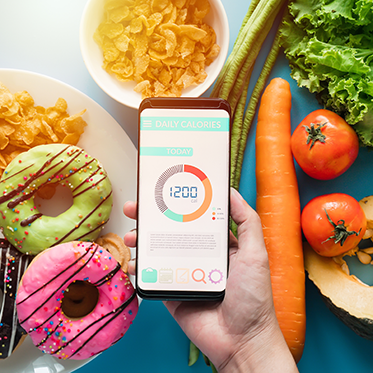
What is a Calorie?
A Calorie
How you fuel your body is the foundation of health. While physical activity is important, what and how much you eat is the predominant (controllable) factor in your weight status and risk for metabolically related chronic disease (1). Making dietary choices that support health begins with understanding the most basic of nutrition concepts: the calorie and energy density.
What is a Calorie?
If you are interested in managing your weight, you should be familiar with “calories,” and the concept of counting them. A calorie isn’t a tangible thing, but a measurement. In technical terms, a calorie is the amount of heat energy necessary to raise the temperature of a single gram of water a single degree (Celsius) (2). Even more, when you are referring to a calorie, you are actually discussing a “kilocalorie” (kcal or “food calories”), which is 1000 calories or the amount of heat energy necessary to raise the temperature of a kilogram of water a single degree. It’s important to have an understanding of calories because excess energy consumption (above what is needed for biological function and energy needs) is stored as fat and has a number of negative health implications (3). The more calories you consume, the greater your risk for weight and metabolically related health issues.


How Is a Calorie Calculated?
How the amount of energy a food provides is determined is likely completely different than you think. One of the primary methods is with a tool known as a bomb calorimeter. To measure the heat released from a specific amount of a solid or liquid substance, a specific amount of that substance is placed inside a crucible (a container in which substances are placed to be exposed to extreme heat) and then the crucible is placed inside a sealed metal cylinder (the “bomb”). The bomb is then filled with oxygen, surrounded by water, and exposed to extreme heat. The heat exposure continues until the substance has completely boiled off, at which point the temperature of the water is measured to determine the calorie count.
There are a few other methods, including the 4-9-4 system developed by 19th century chemist Wilbur Atwater. Knowing that all calories aren’t simply lost through heat, but that the human body expels some, Atwater used known calorie standards and stool samples to determine that proteins and carbohydrates contain approximately 4 calories per gram and that fats contain 9 calories per gram. Although there is quite a bit of modern debate, and the FDA allows for a margin of error up to 20% on food labels, the Atwater equation is still the most predominant method for individuals to determine the energy density of food and their own total intake (4).
A Calorie is a Calorie, is a Calorie
One of the most heavily debated topics in health science is “calories in, calories out” (5). While in general, the most direct way to manage weight is through manipulation of the energy balance equation (calories in minus calories out), there is a growing body of research dating back over a century that suggests that the first law of thermodynamics—energy can neither be created nor destroyed; energy can only be transferred or changed from one form to another—may not be completely relevant to humans and their goal of managing weight (6, 7). Contemporary scientific research has shown that there are countless factors including cooking, digestibility, and industrial processing involved in how a calorie affects the body (8). Furthermore, there is clinical evidence to suggest that significant long-term caloric restriction may have a number of negative physiological, psychological, and behavioral outcomes (9). What is generally accepted is the concept of “caloric density.” Foods that have low energy (and high nutrient composition) in relation to weight or volume tend to promote healthy weight management (10). Low-energy density foods also tend to have other common characteristics:
GLYCEMIC INDEX
The glycemic index measures how the consumption of specific foods affects your blood glucose concentrations (13). There is a strong association between foods that are low on the glycemic index and energy density (14). Furthermore, clinical research has suggested that lower glycemic foods offer improved satiety and possibly better weight management outcomes, especially when on a calorie-restricted diet (15).
WHOLE FOODS
Recent research has shown that the higher the percentage of processed food (substances several steps removed from their natural form) in one’s diet, the higher the overall caloric intake and risk for weight gain (11). Fruits, vegetables, legumes, oats, and other foods in their natural form tend to have lower energy density and promote health.
FIBER
The roughage in plant-based foods that your body can’t break down are vitally important for overall health. Because it passes through the body undigested, fiber helps moderate blood glucose levels and support overall metabolic health. Clinical research has shown that fiber intake is greatly associated with healthy outcomes in those looking to manage weight with moderate calorie-restriction diets (12).
A diet consisting primarily of whole, low-energy density foods is the most evidence-based way to support weight management and overall health (16, 17). Talk to your Prime Meridian Healthcare provider to learn how better dietary choices and a low-energy density diet can support your health goals.


